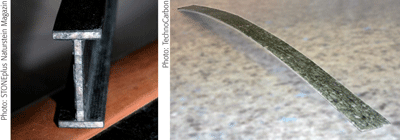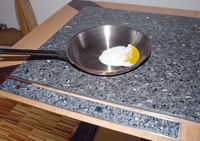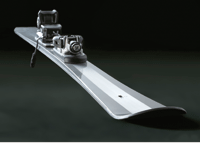
Towards a Green Stone Age?

The ratio of pressure stability to specific weight of CFS is twice that of construction steel, aluminium or concrete. Shown here in the form of a granite beam and a flexible strip.
A small German engineering firm, TechnoCarbon Technologies, has developed a new composite material that its inventors hope may contribute to cutting greenhouse gas emissions in the construction and manufacturing sectors. They talked to WIPO Magazine about the innovation process, about the use of IP in commercializing the resulting products, and about their plans for licensing the technology at low cost for developing country markets.
“This,” declares Kolja Kuse, “is the past.” He leans across the aisle of the bus to hand us a heavy steel joist. “And this,” he says, with a rhetorical flourish, unsheathing a sleek, light-weight bar, “is the future.”
Inventor Kolja Kuse and two business partners were en route to the UN Climate Change Conference in Bali, Indonesia. Their mission: to seek partnerships to promote their innovative construction material, which they believe can play a part in reducing global carbon emissions.
Granite sandwich
The new, high performance composite, known as CarbonFibreStone (CFS), consists of a slice of granite with a fine laminate of carbon fiber on one or both sides. “– A bit like a stone-and-carbon-fiber sandwich,” explains Kolja. The resulting material is not only elastic, but is as strong as construction steel, as light as aluminium and has better vibration-damping properties than any other known pressure-resistant material.
The story began ten years ago in Kolja Kuse’s garage. He was at the time an electrical engineer at Aachen University, specializing in energy production. His brother was a stone mason. Watching his brother at work one day as he cut a slab of granite to make a kitchen worktop, Kolja imagined a polished stone stove-top, with invisible induction coils hidden beneath a perfect, seamless working surface. Not given to idle dreaming, he built one.
“It looked great,” he recalled. “But when the hob got above a certain temperature, the stone would always expand then crack, like an explosion.” He tried compressing the edges with huge machines, but it was no good. “The mechanical engineers and material scientists told me, you can’t stop the stone expanding. It’s impossible. So I pretty much gave up on the idea.”
Break through
There followed one of those moments of serendipity that often precede a technological breakthrough. Flying home to Munich from a meeting, Kolja picked up a brochure about carbon fiber production which had been left on the seat. Carbon fiber, he learned, shrinks longitudinally when heated. Intrigued, he wondered what might happen if he were to coat his beloved granite with carbon fiber. He teamed up with a carbon fiber specialist and gave it a go. Somewhat to their astonishment, the experiment was a success. No matter how high they heated the new hob, the stone never fractured.

A seamless stone cooking hob. Photo © STONEplus Naturstein Magazin
The explanation for the phenomenon, as they subsequently discovered, lay in a complex field of applied mechanics beyond Kolja Kuse’s own area of expertise. But the hunch had paid off. Engineers at the University of Munich subjected a prototype leaf-spring made of CFS to extensive testing and found outstanding resistance to fatigue. With several more years of research, testing and refinement, the new composite was ready for the market. In 2007 it was awarded a Material of Excellence certificate by the trade publication, Material ConneXion.

The CFS core in the Spada ski provides elasticity combined with greater vibration-damping than carbon fiber, resulting in what manufacturer Zai describes as “incomparable smoothness and agility.” Photo: Zai AG
The stone stove is now a reality, marketed by Spring Switzerland AG. As indeed is a high-tech ski with a CFS core, produced by Swiss manufacturer Zai, for which TechnoCarbon and Zai AG shared a Best Product award at the 2007 Materialica trade fair.
Further licensing deals with several other companies are under negotiation. But this is only the beginning of what the TechnoCarbon team sees as virtually unlimited industrial applications.
Companies within the carbon fiber industry have been quick to see the benefits of collaboration. Because of very high production costs, carbon fiber itself has tended to be used mostly in specialized applications, such as Formula One racing cars, aircraft parts, or high end sports equipment. The option of combining carbon fiber with CFS technology opens a range of possibilities in the manufacturing and construction sectors which would not otherwise have been thought economically viable.
Green vision
The team’s vision is that CFS technology will lead to greener building and contribute to sustainable development by replacing steel, aluminium and even concrete. 60 percent of the earth’s mantle consists of granite, they point out. And as it comes out of the ground “ready baked,” it needs no smelting.
TechnoCarbon’s initial calculations suggest that CFS production generates less than half of the carbon emissions of steel, aluminium or carbon fiber production, including the energy required to quarry and process the stone. “It is true that, by volume, CFS would consume as much energy to produce as aluminium,” notes Kolja Kuse. “But it has ten times more tensile strength. So even with a 5:1 ratio of stone to carbon fiber for high load bearing cases, the production energy would decrease by something approaching a factor of four in comparison to aluminium.”
Building on IP in developing countries
“Without international IP rights, we would have no business model.”
Kolja Kuse is animated on the subject of IP. “Without international IP rights, we would have no business model,” he says emphatically. He now has two published PCT applications relating to the technology and its applications, filed on the advice of his lawyer uncle as the most efficient means to protect the invention in international markets. “Though what patent lawyers don’t warn you,” he adds ruefully, “is how much it might cost to defend your patent once you’ve got it.” They have also registered CFS (CarbonFibreStone) and Techno Carbon Technologies as trademarks, with a view to developing a “CFS inside” branding strategy.
He and the ten staff now working for TechnoCarbon Technologies are committed to using their IP to help make the technology available for industrial use in developing countries. They have partnered with Granidus, a small NGO in Berlin run by Matthias Bieniek, to explore technology transfer opportunities. The company plans to channel up to 80 percent of their profits from commercial licensing deals into subsidizing the transfer of CFS to developing countries. “We are also looking at possible cross-licensing arrangements with technology companies in developing countries,” Matthias told us. “The ideal would be to encourage them to develop their own new CFS applications for local needs, and then to help them with the patenting.”
The newest member of the team, Peter Kriebel, joins us on the Bali bus. Inspired by the potential of CFS, he had just left a lucrative banking career in Switzerland to head up TechnoCarbon’s business development. “It was a no brainer!” he says: “- A project for the heart as well as for the head.”
By Elizabeth March, WIPO Magazine Editor, Communications and Public Outreach Division.
Related Links
The WIPO Magazine is intended to help broaden public understanding of intellectual property and of WIPO’s work, and is not an official document of WIPO. The designations employed and the presentation of material throughout this publication do not imply the expression of any opinion whatsoever on the part of WIPO concerning the legal status of any country, territory or area or of its authorities, or concerning the delimitation of its frontiers or boundaries. This publication is not intended to reflect the views of the Member States or the WIPO Secretariat. The mention of specific companies or products of manufacturers does not imply that they are endorsed or recommended by WIPO in preference to others of a similar nature that are not mentioned.